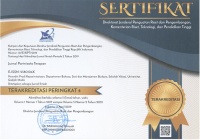Rekomendasi untuk Situs Web DMO (Destination Management Organization) Wonderful Indonesia Berdasarkan Dimensi Informasi pada Model ICTRT
I Putu Sudhyana Mecha(1*)
(1) Politeknik Negeri Banyuwangi
(*) Corresponding Author
Abstract
Website is one kind of information media that can be used as intermediaries of tourism information. Related to that matter, Wonderful Indonesia tourism website has an important role as national-level DMO (Destination Management Organization). However, it has not been recognized yet as something important in term of tourism, especially when viewed from information dimension. Therefore, evaluation based on IPA (Importance-Performance Analysis) was carried out in order to arrange recommendation for Wonderful Indonesia tourism website. Sampling was conducted to travel agencies from ASITA (Association of Indonesian Tours & Travel Agencies) Bali, as the representative of tourism practitioners. Moreover, considering their role as intermediaries between tourism information and the tourists. Based on the results of evaluation, there was two indicators, such as accommodation information and local weather information that needed to be paid more attention. Regarding the evaluation above, further interviews were also conducted in order to get cross-check feedback, so it can be more convincing as recommendation. The interview was based on the experts that coming from government, practitioner, and academics related to tourism as stakeholders, so the recommendation for Wonderful Indonesia website is expected to be proper use according to the needs of users of tourism information.
Keywords
Full Text:
PDFReferences
Benckendorff, P. J., Sheldon, P. J., & Fesenmaier, D. R. (2014). Tourism Information Technology, 2nd Edition (2nd ed.). Boston, MA: CABI. Buhalis, D. (2000). Marketing the competitive destination of the future. Tourism Management, 21, 97-116. Buhalis, D., & Amaranggana, A. (2014). Smart Tourism Destination. Information and Communication Technologies in Tourism 2014 (pp. 553-564). Dublin, Ireland: Springer. Buhalis, D., & Law, R. (2008). Progress in information technology and tourism management: 20 years on and 10 years after the internet: The state of eTourism research. Tourism Management, 29, 609-623. Buhalis, D., & Wagner, R. (2013). E-destinations: Global Best Practice in Tourism Technologies and Applications. Information and Communication Technologies in Tourism 2013 (pp. 119-130). Innsbruck, Austria: Springer. Dewantara, M. H. (2015). ANALISIS DAN PENGEMBANGAN SITUS RESMI PARIWISATA INDONESIA DAN SISTEM INFORMASI PENDUKUNGNYA. Jurnal Master Pariwisata , 1(2), 9-24. Groth, A., & Haslwanter, D. (2015). Perceived Usability, Attractiveness and Intuitiveness of Responsive Mobile Tourism Websites: A User Experience Study. Information and Communication Technologies in Tourism 2015 (pp. 593-606). Lugano, Switzerland: Springer. Ho, C.-I., Lin, M.-H., & Chen, H.-M. (2012). Web users’ behavioural patterns of tourism information search: From online to offline. Information and Communication Technologies in Tourism 2012 (pp. 1468-1482). Helsingborg, Sweden: Springer. Li, N., Buhalis, D., & Zhang, L. (2013). Interdisciplinary Research on Information Science and Tourism. Information and Communication Technologies in Tourism 2013 (pp. 302-313). Innsbruck, Austria: Springer. Lim, Y. S., & Yoo, E. E. (2012). TripAdvisor.com vs. NYCGO.com: Evaluation of Functional Components of Generalist and Specialist Tourism Websites. Information and Communication Technologies in Tourism 2012 (pp. 120-131). Helsingborg, Sweden: Springer. Linaza, M. T., Agirregoikoa, A., Garcia, A., Torres, J. I., & Aranburu, K. (2011). Image-based Travel Recommender System for small tourist destinations. Information and Communication Technologies in Tourism 2011 (pp. 1-12). Innsbruck, Austria: Springer. Lytras, M., Pablos, P. O., Damiani, E., & Dias, L. (2010). Digital Culture and E-Tourism (Technologies, Applications and Management Approaches) (1st ed.). USA: IGI Global. Magasic, M. (2016). The ‘Selfie Gaze’ and ‘Social Media Pilgrimage’: Two Frames for Conceptualising the Experience of Social Media Using Tourists. Information and Communication Technologies in Tourism 2016 (pp. 173-182). Bilbao, Spain: Springer. Marchiori, E., Milwood, P., & Zach, F. (2013). Drivers and Benefits of Analysing DMOs’ eWOM Activities. Information and Communication Technologies in Tourism 2013 (pp. 107-118). Innsbruck, Austria: Springer. Mecha, I. P., Wiranatha, A. S., & Sudiarta, I. N. (2019). EVALUASI SITUS WEB PARIWISATA WONDERFUL INDONESIA BERDASARKAN MODEL ICTRT (INFORMATION, COMMUNICATION, TRANSACTION, RELATIONSHIP, AND TECHNICAL-MERIT). Jurnal Master Pariwisata, 5(2), 241-258. Neuhofer, B. (2012). An Analysis of the Perceived Value of Touristic Location Based Services. Information and Communication Technologies in Tourism 2012 (pp. 84-95). Helsingborg, Sweden: Springer. No, E., & Kim, J. K. (2015). Comparing the attributes of online tourism information sources. Computers in Human Behavior, 50, 564-575. Sung, T. K. (2018). Industry 4.0: A Korea perspective. Technological Forecasting & Social Change, 132, 40-45. Yannacopoulos, D., Manolitzas, P., Matsatsinis, N., & Grigoroudis, E. (2014). Evaluating Websites and Web Services: Interdisciplinary Perspectives on User Satisfaction (1st ed.). United States of America: IGI Global.
Article Metrics
Refbacks
- There are currently no refbacks.
Copyright (c) 2020 I Putu Sudhyana Mecha

This work is licensed under a Creative Commons Attribution-ShareAlike 4.0 International License.













